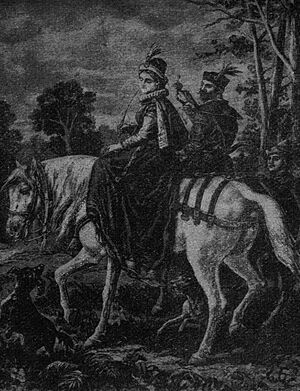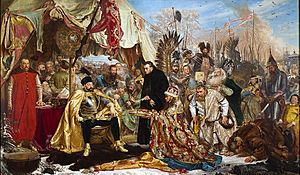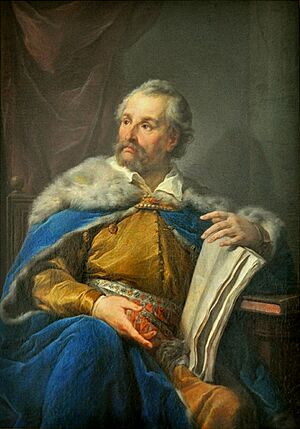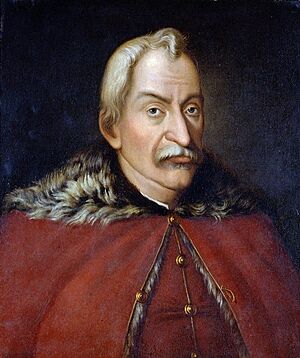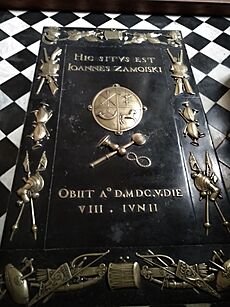Jan Zamoyski facts for kids
Quick facts for kids
Hetman
Jan Zamoyski
|
|
|---|---|
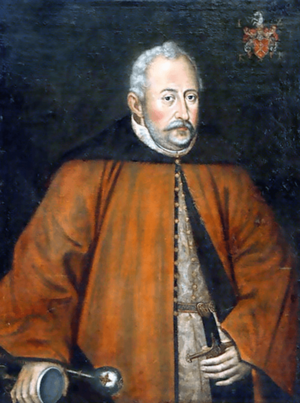
Portrait by Jan Szwankowski, ca. 1602
|
|
| Grand Crown Chancellor | |
| In office 1578–1605 |
|
| Monarch | Stephen Bathory Sigismund III |
| Preceded by | Piotr Dunin Wolski |
| Succeeded by | Maciej Pstrokoński |
| Great Crown Hetman | |
| In office 1581–1605 |
|
| Monarch | Stephen Bathory Sigismund III |
| Preceded by | Mikołaj Mielecki |
| Succeeded by | Stanisław Żółkiewski |
| Personal details | |
| Born | 19 March 1542 Skokówka, Kingdom of Poland |
| Died | 3 June 1605 (aged 63) Zamość, Polish–Lithuanian Commonwealth |
| Resting place | Cathedral of the Resurrection, Zamość |
| Spouses | Anna Ossolińska Krystyna Radziwiłł Gryzelda Batory Barbara Tarnowska |
| Children | Tomasz Zamoyski |
| Parents |
|
| Alma mater | University of Padua |
| Occupation | Politician, magnate, soldier |
| Noble family | Zamoyski |
| Signature |  |
| Nickname | Polish Gracchus |
| Military service | |
| Allegiance | Polish–Lithuanian Commonwealth |
| Years of service | 1565 – 1605 |
| Battles/wars | War of the Polish Succession (1587–88):
|
Jan Zamoyski was a very important Polish nobleman, statesman, and military leader. He was born on March 19, 1542, and passed away on June 3, 1605. He held many powerful positions in the Polish–Lithuanian Commonwealth.
From 1565, he was the Royal Secretary. Later, he became the Deputy Chancellor in 1576. He then rose to Grand Chancellor of the Crown in 1578. In 1581, he became the Great Hetman of the Crown, which meant he was the top military commander.
Zamoyski was also the General Starost of Kraków from 1580 to 1585. He advised Kings Sigismund II Augustus and Stephen Báthory. He was known as a skilled diplomat and politician. He played a big role in the Commonwealth's history.
Contents
Jan Zamoyski's Life

Early Life and Learning
Jan Zamoyski was born in Skokówka. His parents were Stanisław Zamoyski and Anna Herburt. He started school in Krasnystaw.
When he was thirteen, he went to study in Paris. From 1555 to 1559, he was a page at the French royal court. He also attended lectures at famous universities like the Sorbonne.
In 1559, he visited Poland briefly. Then he studied at the University of Strasbourg. After a few months, he moved to the University of Padua in Italy. There, he studied law and earned a doctorate in 1564. During his time abroad, he changed his religion from Calvinism to Roman Catholicism.
He was very active in university life. In 1563, he was chosen as the head of the law department. He also wrote a booklet about the government of Ancient Rome. He returned to Poland in 1565.
-
A bust of Zamoyski at the University of Padua, where he was a student and a leader.
Starting His Career
After returning to Poland, Jan Zamoyski joined the Royal Chancellery. He quickly became a favorite secretary to King Sigismund II. In 1567, he led a royal team to take back royal lands. He also helped organize the Chancellery's records.
In 1571, he married Anna Ossolińska. Sadly, she and their young son passed away soon after.
After the Jagiellon royal family ended in 1572, a new king needed to be chosen. Zamoyski pushed for all nobles to vote for the new king. He was a leader for the lesser and middle nobility. They wanted to reform the country and keep its unique government. He was so popular that people called him the "first tribune of nobility."
Becoming a Chancellor and Hetman
In the first election, Zamoyski supported Henry de Valois. He even went to France to finalize things with the new king. But Henry secretly left Poland, which was embarrassing for Zamoyski.
In the next election in 1575, Zamoyski strongly opposed the Habsburg family. This made him popular again with the nobles. He supported a Polish candidate, which led to Anna Jagiellon marrying Stephen Bathory of Transylvania.
King Bathory rewarded Zamoyski. He made him Deputy Chancellor in 1576. Zamoyski helped the king put down a rebellion in Danzig in 1576–1577. He even fought in battles himself. In 1577, he married Krystyna Radziwiłł. This made him an ally of the powerful Radziwiłł family. In 1578, he became the Grand Crown Chancellor.
Zamoyski helped prepare for a war against Muscovy (Russia) from 1579 to 1581. He provided soldiers and showed great skill in military matters. Even though he had little experience, he learned quickly. He also made sure the war had political support. In 1580, his wife died, which made him very sad.
Later that year, he captured Velizh and took part in the siege of Velikiye Luki. On August 11, 1581, he was named Grand Crown Hetman. This was a very important military position. He then joined the long siege of Pskov. This siege ended with a peace treaty in 1582 that was good for Poland.
In 1583, Zamoyski married his third wife, Gryzelda Bathory, who was related to the king. In 1584, Zamoyski's men captured Samuel Zborowski, a noble who had been sentenced to death. Zborowski was executed with the king's approval. This event caused a big debate in Polish politics.
Later Years and Challenges
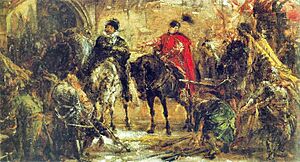
After King Bathory died in 1586, Zamoyski helped Sigismund III Vasa become the new Polish king. He fought in a short civil war against forces supporting another candidate. Zamoyski defended Kraków and defeated the enemy in the Battle of Byczyna in 1588. This battle was very important for Zamoyski's military career. The defeated leader was captured, and a treaty was signed.
From 1589, Zamoyski tried to stop Tatar raids on the southern border. He also planned to make Moldavia a safe zone between Poland and the Ottoman Empire. This led to a long military campaign.
Opposing the King
Over time, Zamoyski started to disagree with King Sigismund III. The king wanted to ally with the Habsburgs and use Poland to gain the Swedish crown. Zamoyski feared the king wanted to make Poland an absolute monarchy, which meant the king would have all the power. Zamoyski wanted to protect the Commonwealth's unique government where nobles had a strong voice.
The king could not fire Zamoyski from his powerful positions. Their disagreements became public in 1591. Despite their tense relationship, neither wanted a civil war. Zamoyski apologized to the king, and they continued their uneasy partnership.
In 1595, Zamoyski won the Battle of Cecora in Moldavia. He helped a new ruler, Ieremia Movilă, take the throne. In 1600, he fought against Michael the Brave and restored Ieremia to power. He also helped Ieremia's brother become ruler of Wallachia, expanding Poland's influence.
From 1600 to 1601, Zamoyski fought in the war against Sweden in Livonia. He recaptured several strongholds. However, the hard campaign affected his health, and he resigned his command.
In 1603, Zamoyski led the opposition against the king's plans to change the government. He believed these changes would lead to an absolute monarchy. He also opposed the king's plans to get involved in a civil war in Muscovy. Zamoyski had his final disagreement with the king in January 1605.
Jan Zamoyski passed away suddenly on June 3, 1605, from a stroke. His son, Tomasz Zamoyski, inherited his wealth.
Jan Zamoyski's Legacy
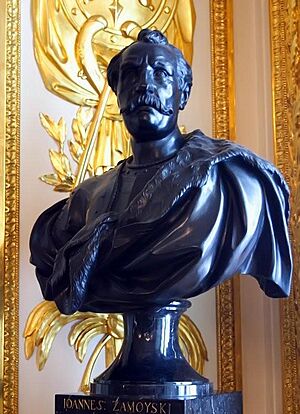
Jan Zamoyski's fame continued after his death. Many artists and historians praised him. He is seen as a very important figure in Polish history. He appears in famous paintings by Jan Matejko, like Batory at Pskov.
A Powerful Leader
Zamoyski held both the Chancellor and Grand Hetman offices. This made him one of the most powerful people in the country. He was in charge of much of Poland's internal and foreign policies. He is considered one of the most important statesmen in Polish history.
Even though he started his military career later, Zamoyski became a very skilled commander. He liked using sieges and clever maneuvers. He was good at leading in both sieges and open battles.
Wealth and Supporting Arts
Zamoyski became very wealthy. His lands brought in a lot of money. He owned many towns and villages. In 1589, he created the Zamoyski Family Fee Tail, which was like his own small duchy. He helped his lands grow by investing in new settlements and industries.
His most famous creation was the city of Zamość. He founded it in 1580. It was designed as an "ideal city" by an Italian architect. In Zamość, he founded the Akademia Zamojska in 1595. This was the third university in Poland's history. He also funded four other towns.
Zamoyski had a large library and supported many artists. He helped poets like Jan Kochanowski and historians like Joachim Bielski.
His Character
Zamoyski was known for being very intelligent. He was a clever strategist in politics and war. He was also a popular leader. He cared deeply about the good of his country. Even though he could have tried to become king, he chose to work within the law. He wanted to avoid a civil war that would harm Poland.
See also
- Army of the Polish–Lithuanian Commonwealth




